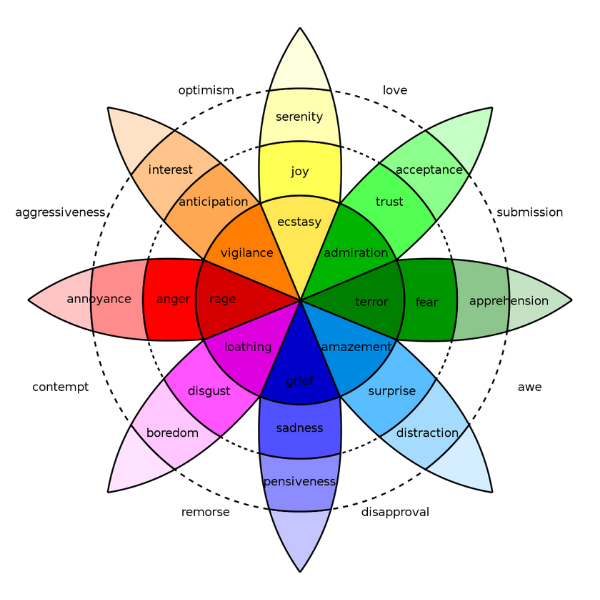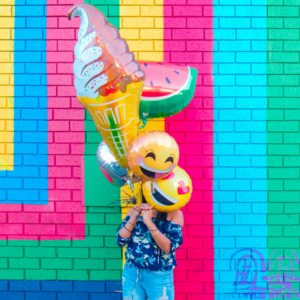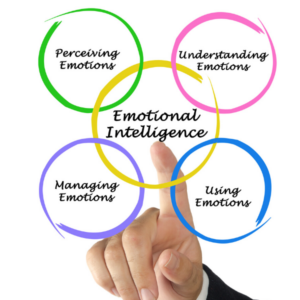
This pandemic and the stress of the unknown and the uncertainty regarding what is to come can make anyone feel tired, confused, and uncertain.
All these feelings can be rolled up into a primary emotion called, fear.
Yes, fear, is one of the 8 basic emotions humans experience.
At the time, we might struggle to describe the emotion we are feeling.
What helps with this is to gain greater emotional literacy and to grow your emotional vocabulary.
I’ve designed a low-cost, self-directed e-course to help you do just that!
It’s called, Foundations of Emotional Intelligence and it offers short, practical, and engaging lessons that will help you gain more control of your emotions,
be able to name them, and connect to why you’re experiencing the emotion in the first place.
Let’s take a closer look at the 8 basic emotions. They are:
Joy, Trust, Fear, Suprise, Sadness, Anticipation, Anger, and Disgust.

Robert Plutchik’s Wheel of Emotions
Now I bet you’re wondering how there can be just 8 emotions.
Well, in Robert Plutchik’s Wheel of Emotions, he describes how you can use the wheel to connect with many other emotions that are either more or less intense.
It is helpful to consider how this wheel of emotions works.
Let’s take a quick look at how to interpret it. So, what do all those colors and petals mean?
As mentioned, the eight primary emotions are anger, anticipation, joy, trust, fear, surprise, sadness, and disgust.
For each primary emotion, there is a polar opposite.
- Joy is the opposite of sadness.
- Fear is the opposite of anger.
- Anticipation is the opposite of surprise.
- Disgust is the opposite of trust.
Let’s now look at combinations:
The emotions with no color represent an emotion that is a mix of the 2 primary emotions.
For example, anticipation and joy combine to be optimistic.
Joy and trust combine to be love. Emotions are often complex, and being able to recognize when a feeling is actually a combination of two or more distinct feelings is a helpful skill.

Emotions intensify as they move from the outside to the centre of the wheel, which is also indicated by the colour.
The darker the shade — the more intense the emotion.
Anger, when it is least intense could be call annoyance. At its highest level of intensity, anger turns to rage.
A feeling of boredom can intensify to loathing, which is dark purple.
Think for a moment about a relationship you have where emotions were unchecked. Did the emotion go away or did it intensify?
It probably intensified.
This is an important connection and why it is important to develop self-awareness and your emotional vocabulary.
You need to be able to name the emotion you’re experiencing before you can effectively navigate it.
The more you able to recognize your emotions the more you’ll become self-aware and more you’ll be in tune with what triggered the emotion.
You’ll be able to decide — intentionally — how you want to respond to the emotion and not let the emotion rule you.
When you let your emotions rule you, you carry the weight of the emotion and use up energy far longer than the emotion warrants.
Check out my blog post on emotional triggers.
Holding onto lingering negative emotions can cause you to make decisions that are not healthy or to feel anger, sadness, disappointment, frustration, or other worse.
To bring this point home, I’d like to share a Zen story with you.

An old monk is traveling with a young monk when they come to a place in a river shallow enough to wade across.
At the crossing point, they encounter a prostitute who appears to want to cross the water but is hesitating.
The old monk walks up to her, introduces himself, and asks if he can help her across.
The woman gratefully accepts. So he lifts her on his back and they cross the stream, followed sullenly by the young monk.
On reaching the other side, the two monks leave the woman and carry on in silence.
After several miles, the young monk, clearly troubled by what took place at the river, admonishes his older companion,
“Monks should not touch women like that, let alone carry them in their arms.”
The old monk looks quietly at the younger man for a few moments, then nods and says,…
“I left the woman at the riverbank, but you are still carrying her.”
My e-course is designed to help you recognize your emotions and learn ways to let go of emotions that don’t serve you.

Gaining self-awareness about your emotions is the starting point for growing this skill.
More than IQ, experience, or technical knowledge, emotional intelligence is a key competence employer seeks and what great leaders focus on developing and fine-tuning throughout their career.
“If your emotional abilities aren’t in hand, if you don’t have self-awareness, if you are not able to manage your distressing emotions, if you can’t have empathy and have effective relationships, then no matter how smart you are, you are not going to get very far.” — Daniel Goleman
To explore more on this topic there are many great books on my Resources page.



